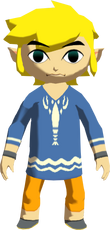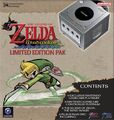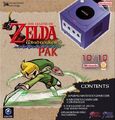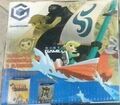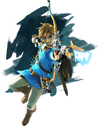(→Trivia) |
(→Trivia) |
||
| Line 251: | Line 251: | ||
**The version of the [[Dragon Roost Island]] theme found on the game's [[The Legend of Zelda: The Wind Waker Original Sound Tracks|soundtrack]] includes a plucked bass, which is not present in the original version of the theme found in the game. The version with the plucked bass was also used in ''Super Smash Bros. Brawl''. |
**The version of the [[Dragon Roost Island]] theme found on the game's [[The Legend of Zelda: The Wind Waker Original Sound Tracks|soundtrack]] includes a plucked bass, which is not present in the original version of the theme found in the game. The version with the plucked bass was also used in ''Super Smash Bros. Brawl''. |
||
*Although the Korean version of ''The Wind Waker'' is actually the American version with Korea-specific region coding, its boxart is almost identical to that of the Japanese version, with the Japanese logo swapped out for the English (international) one. |
*Although the Korean version of ''The Wind Waker'' is actually the American version with Korea-specific region coding, its boxart is almost identical to that of the Japanese version, with the Japanese logo swapped out for the English (international) one. |
||
| − | *This is the fourth The Legend of Zelda title to be remade as well as the |
+ | *This is the fourth The Legend of Zelda title to be remade as well as the third console Zelda title to have a remake. |
==Gallery== |
==Gallery== |
||
Revision as of 21:13, 16 December 2014
Template:GameNav
- This page is about the Nintendo GameCube game. For the Wii U remake, see The Legend of Zelda: The Wind Waker HD.
Template:Game
| This is but one of the legends of which the people speak... | ||
| — Prologue | ||
The Legend of Zelda: The Wind Waker is the tenth installment of the Zelda series. It is the first Zelda game for the Nintendo GameCube, and was released in Japan on December 13, 2002, in Canada and the United States on March 24, 2003, in South Korea on April 16, 2003, in Europe on May 3, 2003 and in Australia on May 7, 2003.
The Wind Waker is notable for being the first game in the series to employ cel-shading, a lighting and texturing technique that results in the game having a cartoon-like appearance. It also differentiates itself from other Zelda games with its massive overworld, the Great Sea (which may be the largest overworld of any Zelda game), which must be explored using a boat, the King of Red Lions. It is an indirect sequel to Ocarina of Time,[1] taking place several hundred years after the events of the previous games.[2]
Although the sea-faring gameplay and cartoon-like graphics were a point of critique for some, The Wind Waker was in the end the fourth best-selling GameCube game of all time.[3] However, it should be noted that pre-orders of the game were significantly boosted by the inclusion of a pre-order bonus disc, which features Ocarina of Time and Template:OoTMQ. Master Quest is an enhanced remake of the original Ocarina game, with partially re-designed, more difficult dungeons.
In 2007, a direct sequel to The Wind Waker, entitled Phantom Hourglass, was released on the Nintendo DS.
In the fall of 2013, a remake of the game was released for the Wii U console, with enhanced graphics and gameplay in a fashion similar to Template:OOT3D.
Story
Synopsis
The title screen.
Set hundreds of years after the events of Ocarina of Time, The Wind Waker finds the hero Link in a sea scattered with 49 islands, which necessitates frequent sailing and naval combat. Link lives with his grandmother and younger sister Aryll on Outset Island, one of the few inhabited islands in the Great Sea. The people of the Great Sea pass down a legend of a prosperous kingdom with a hidden golden power. An evil man found and stole this power, using it to spread darkness until a young boy dressed in green sealed the evil with the Blade of Evil's Bane. The boy became known as the Hero of Time and passed into legend. One day the sealed evil began to return, but the Hero of Time did not reappear. The inhabitants of the Great Sea are unsure of the kingdom's fate, but it is clear that this legend is the story of Ocarina of Time where the Hero of Time, Link, fought Ganondorf.
When boys of Outset Island come of age, they are customarily dressed in green, like the Hero of Time. The elders hope to instill the courage of the Hero of Time in the children. It is Link's birthday as The Wind Waker opens, and he receives the familiar green clothes and cap as a present from his grandma. Aryll's present to Link is permission to use her telescope. As he looks through the telescope, he sees a large bird, the Helmaroc King, carrying a girl to a nearby forest. After retrieving a sword, Link sets out to investigate. Link rescues the girl, only to have Aryll kidnapped by the Helmaroc King as he returns.
The Great Flood
The memory of the kingdom vanished, but its legend survived on the wind's breath.
Ganondorf, the great evil that all still thought to be sealed away in the Sacred Realm of Hyrule, crept forth, eager to resume his dark designs. As the darkness was spreading over the kingdom, the people hoped that the Hero of Time would once again appear to save them, but the hero did not appear. Ganon’s next step was to make another aggressive move for the Triforce. The king, Daphnes Nohansen Hyrule, attempted to stop the fiend, but was not strong enough.
As doom drew nigh, the king and his people prayed to the gods, leaving their kingdom in the hands of fate. The goddesses answered their prayers by instructing those chosen to flee for the mountaintops, before they flooded the land. Ganondorf and his minions were sealed along with Hyrule in an enchanted air chamber at the bottom of the sea, with the Master Sword serving as the key suspending the flow of time within the chamber.
Over the centuries, the memory of the kingdom vanished, but its legend survived on the wind’s breath. On a certain island at the south of the Great Sea, it was customary to garb young boys in green when they came of age. The youths aspired to find heroic blades and cast down evil, but the elders wished only for the youths to know courage like the hero of legend.
Link's Quest
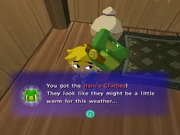
Link getting his new tunic.
On that island, a young boy named Link finally comes of age to wear the green of the hero. Unfortunately, his birthday plans were about to be dashed. A giant bird flew over his island, carrying a young girl in its talons. Hot on its tail is a pirate ship, sending a catapult barrage after it in an attempt to force it to touch down. One of the projectiles causes the bird to drop the girl, who lands in a tree in the forest atop the island. Link grabs a sword and rushes off to find the girl. Her name is Tetra, and Link learns that she is the captain of that band of pirates.
As Link leads her back to her ship, the bird swoops down and kidnaps Link’s younger sister, Aryll, mistaking her for Tetra. A Rito postman informs the stunned Link and the unsympathetic Tetra of stories of a large bird who kidnapped young girls with long ears and took them back to the cursed Forsaken Fortress.[4] He charges Tetra with helping young Link rescue his sister from that wicked place. Tetra reluctantly accepts, and with her help, Link is able to infiltrate the fortress and reach the cell where his sister was being kept. But the great bird discovers him, and, at the command of a sinister shadowy figure, it hurls him into the sea.
He is recovered by a talking boat, who introduces itself as the King of Red Lions. The King tells him of the story behind that shadowy figure, and the threat that that wrongdoer posed. The shadow was Ganon. Somehow, someway, the seal of the gods had failed. Ganon had returned, and the world was once again in danger.[5] The key to defeating Ganon was locked away in a great power that could only be wielded after much toil and hardship. Only one who was able to overcome the trials that awaited in the Tower of the Gods would be permitted to wield the power to destroy the great evil. That power was none other than that of the Master Sword, the blade of evil’s bane, and it could banish Ganon from the world above. Or, at least, so the King of Red Lions believed.[6]
Before entering the Tower of the Gods, Link has to gather the three Goddess Pearls, which he accomplishes with the help of an ancient conductor’s baton called the Wind Waker. Though he does, indeed, succeed in the trials of the gods and claims the Master Sword from Hyrule below, when he returns to the Forsaken Fortress, destroys the monstrous bird, and proceeds to challenge Ganondorf, he learns of the unfortunate fate that had befallen the Master Sword, that it no longer sparkled with the power to repel evil.[7] As it is revealed later in the game, Ganondorf had already attacked the temples where the sages were praying to the goddesses so that the Master Sword could retain its power to repel evil.[8] He also gathered that by withdrawing the blade from its place in Hyrule Castle, he had broken the final seal placed by the gods on Hyrule and on Ganondorf’s magic, stirring all the monsters frozen in time in the kingdom below from their centuries-long slumber.[9]
Tetra rushes to his rescue, and yet another revelation transpires. When Tetra approaches Ganondorf, his Triforce of Power resonates. This could only mean one thing—Tetra possessed the Triforce of Wisdom, none other than the sacred power of the gods that the royal family had kept from Ganon’s clutches for so many long years. Her mother had instructed her to keep it close, and to safeguard it always. The Triforce of Wisdom was proof of her birthright—Tetra was the true heir to the royal family of Hyrule, the last link in the bloodline. Tetra was Princess Zelda. Of course, Ganondorf notices this immediately, and so he tries to seize the Triforce of Wisdom then and there.[10] Luckily, a pair of Rito manage to swoop down and rescue the children from Ganondorf’s grip.
Zelda is brought to Hyrule Castle below the waves, and the King of Red Lions imparts news of her identity and her role in these events before giving her the missing shard of the Triforce of Wisdom. He then instructs her to remain in Hyrule and sends Link back to the sea above to reawaken the Master Sword’s power and reunite the Triforce of Courage—split when the Hero of Time left the land after completing his mission[11]—until then, the portal to the world below the waves would be sealed, and he would be unable to return again to Hyrule.
To complete his task, those who carried on the blood of the sages had to be found to take the stead of the old in the temples and ask the gods for their assistance. The Korok Makar and the Rito maiden Medli are the ones who awake as the new sages of Wind and Earth respectively. With their power and prayers, Link is able to restore the blade of evil’s bane to its original form. He then hunts down the scattered shards of the Triforce of Courage and brings the completed piece back to the Tower of the Gods to present it to the gods. The Triforce piece then dwells within him, proving that he is the true hero, the Hero of Time, "reborn". Because Link had used the power of the Wind Waker to travel the Great Sea, the King of Red Lions declares him the Hero of Winds.
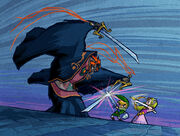
The final battle.
When Link descends beneath the waves, he discovers that Ganon had kidnapped Zelda and taken her to his headquarters, Ganon's Tower, a daunting fortress that even the legendary Knights of Hyrule had been unable to assail in ages past.[12] Link makes haste for the tower, and, when he scales it, Ganon is waiting for him. Ganondorf catches Link off guard and, since he has once again gathered the three crests, he manages to summon the full Triforce. He wishes that the rays of the sun expose Hyrule anew so that the kingdom and the world, may be his.[13]
But the King of Red Lions touches the Triforce first. The King wishes for Hyrule and Ganondorf to be buried beneath the waves of the Great Sea. He also wishes for hope for his descendants; that they might be able to create a better world.[14] The Triforce then vanishes, possibly floating away to the sacred lands to await a new owner.
In a fit of madness, Ganondorf attacks Link. With the Master Sword at its full power, Link deals the final death blow to Ganondorf. Link and Zelda are spirited away to the surface of the sea, and the floodwaters come crashing down, burying Hyrule beneath the sea. Link and Zelda sail away in search of a new land — with the wind as their guide.[15] This scene marks the beginning of the first Nintendo DS Zelda game, Phantom Hourglass.
Gameplay
The Wind Waker, despite initially concerning fans because of its visuals,[16] not only was praised in the graphic department, it also retains many elements from the two N64 Zelda games. As Link progresses through his adventure, he meets and helps many characters, usually leading to rewards. During his quest, he also explores dungeons, solves the puzzles within, fulfills various crucial challenges, and defeats multiple enemies. The game's controls are similar to those of the previous 3D titles as well, albeit with new improvements; for example, the C Stick allows the player to control and adjust the camera. The controller's buttons, once more, are used for multiple actions, including rolling, using the shield or an item. Along with these elements, new ones are implemented, debuting in this game.
Sea Exploration
Template:Main list
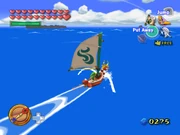
Sailing is the main method of transportation in The Wind Waker.
Like Majora's Mask, The Wind Waker is mainly set outside Hyrule, although the once known Sacred Kingdom is visited this time. Link explores the vast ocean known as the Great Sea, and he travels with the help of the King of the Red Lions, a boat that is capable of human speech.[17] With the help of the titular Wind Waker, Link can control at will the direction of the wind's flow, which is helpful to navigate across the waters.[18] As he does so, he frequently visits multiple islands (49 in total), all of which should have something interesting, from merely a hidden prize to a crucial area related to the main quest. When Link enters the territory of an island, he can ask a Fishman for information on said island, as well as to draw the territory's position in the Sea Chart.
While Link looks for an island, he deals with threats from the sea, including enemy bases, deadly creatures, and natural phenomena. Besides the islands, submarines and the aforementioned enemy bases can be visited as well, usually populated by enemies and housing interesting treasures. Link can foresee sunken treasures (pinpointed by rings of light on the water surface), and he can bring them towards him with the help of the Grappling Hook.
As Link defeats enemies, solves puzzles, helps people, and conquers obstacles, he will often earn Treasure Chart maps. When Link opens one, he can find previously inaccessible prizes, which will then be pinpointed by intensely shiny lights emanating from the sea. Important, as certain key items needed for access to the final level will indeed be hidden under the sea, only located after collecting special charts that, additionally, need to be deciphered somehow.
As with most Zelda games, in The Wind Waker Link learns to Warp from one place to another. This time he does so with cyclones, after defeating an important deity named Cyclos.
GBA interaction
The Wind Waker was the first Zelda game to make use of the connectivity between the Nintendo GameCube and Game Boy Advance. When Link rescues Tingle from his imprisonment in Windfall Island, the 35-year old man will give him the Tingle Tuner, along with the Tingle Chart; after this point, when the player connects a Game Boy Advance to the Gamecube through the Nintendo Gamecube Game Boy Advance Cable, the young hero will be aided by Tingle in many ways.[19] For example, when inside dungeons, he can watch its rooms even if the dungeon map has yet to be collected; Link can also purchase items from Tingle for use, and a special sidequest (also regarding the dungeons) will be unlocked. This is also the only way to find the elusive Knuckle, whose figurine is impossible to obtain otherwise (since he won't appear at all normally in the game).
Wind control and new item usage
Template:Main list As mentioned above, the magical baton gives Link the ability to control the wind's direction as soon as he learns the proper melody. Manipulating the wind not only makes sea navigation faster, it also gives the legendary hero multiple other possible uses for the wind, such as being able to glide with the Deku Leaf for long periods of time, making a character give different notes of information, helping other characters fly farther, and even causing a treasure chest to appear when Link stands before a marked wind spot, among other things. After learning another song, Link can use the power of cyclones to warp from one island to another, reducing the amount of time taken to reach a destination. Other melodies serve purposes less related to wind, but still give more versatility and usefulness to the Wind Waker.
Link can also obtain and use item bags able to house up to eight different item types each, which helps organize items by usage. For example, the Spoils Bag keeps several jewels and items that enemies drop upon death, and can be used for further purposes, such as preparing potions, receiving rewards, or helping people in need of them. The Bait Bag is of great utility as it keeps food for animals and creatures in exchange of either prizes, new information regarding something or even control of seagulls. The Delivery Bag is used to keep letters, souvenirs, or even documents, and is heavily used in a sidequest regarding a trading sequence that ultimately leads to an optional magical artifact.
Some gameplay elements from Majora's Mask also return here with variations and enhancements. Link can again use a Pictograph Box, which this time has a much more extensive use; for example, there is a sidequest, the Nintendo Gallery, that consists of taking a pictograph of every single character, creature, and any other living being, either divine or merely mortal, in the game. The camera can be upgraded to take full-color shots and, unlike in the game it debuted, it can now support three pictographs. Another returning element is the ability to control other characters through psychic faculty. After learning the right melody, Link can control seagulls, statues, and secondary characters he previously met in his travels. This important ability is used in three dungeons, which require the Link to control characters or statues. Unlike in previous Zelda games, The Wind Waker features items with multiple usages. The Grappling Hook, for example, can be used to pass over cliffs and big holes, to steal enemies' items, and to retrieve sunken chests from the sea; the Deku Leaf can be used for flight or to blow gusts of wind. Bombs can now be used both on land and from the boat (the boat includes a long-range cannon used to fire bombs) while at sea. Elemental arrows are now accessed upon usage of the Hero's Bow instead of as separate items; the Hookshot can both take Link to higher spots and, together with the Iron Boots, be used to remove heavy statues out of the way; and the Boomerang can now hit up to five targets with the same launch.
Second Quest
The Wind Waker is the first 3D game in the franchise to feature a Second Quest. When the game is cleared for the first time, the opportunity is given to restart it with some important changes; for example, the outfits for Link and Aryll are different than usual, the Hylian text spoken by Valoo, the Deku Tree, and Jabun are translated into English, and the Deluxe Picto Box is available from the start, which not only makes the Color Pictography Quests possible to do earlier, but allows the player to start the Nintendo Gallery at the start of the game; Nintendo Gallery progress from the completed file is retained in the Second Quest file.
Game Style
The Wind Waker, at first glance, looks less mature than previous installments of the series, but many consider it to be quite emotional, mainly because of the expressiveness of characters, who actually show facial expressions in regards to a situation.[20] However, one may also have interpreted this as a loss of subtlety. Additionally, its graphical style is said by some to evoke the spirit of the older 2D games more than the N64 games did,[21] as this was very difficult to see in the N64 games because of technology constraints. Some also consider the Eastern-inspired music score to have helped recreate the atmosphere of the earlier games.[22]
The game's storyline has more detail and the narrative is much deeper than those of previous games; many aspects of Hyrule's past and its fate are revealed in this game, and it is also revealed that even Ganondorf and the King of Hyrule are more than they appear. Link is aware that he is not alone on his mission and that others are doing their best to help him progress through his mission.
Game Information
Graphics
As previously noted in the above sections, the game makes use of cel-shading graphics. Contrary to popular belief, programming the game with an engine based on this style was more difficult than programming Twilight Princess, after modifying said engine, to favor realistic graphics.[23] The style was influenced by the input of a former Japanese animator, whom Nintendo consulted for inspiration.[24] The cel-shaded graphics style was found to mask system limitations well and was later adopted for handheld Zelda games such as The Legend of Zelda: Phantom Hourglass.
Among the visual effects present in the game are the smoking explosion the enemies and most bosses experience after being defeated, as well as the drawings indicating the wind's blow. Also, when something is hit, an instant spark of light can be seen that can light up nearby areas. Characters' clothes and hair, as well as flags, leaves, trees, and other loose objects are affected by a real-time cloth simulation engine. These elements were present to a limited degree in the prior games for Nintendo 64, though in this game, they are exaggerated, in part due to the use of cel-shading. Detailed character and object shadows were also implemented (this was present in the N64 games' data but strangely unused).
The Wind Waker is unique among cel-shaded video games for its lack of an outline around displayed objects and its usage of detailed textures. The usage of advanced effects, such as light-mapping, heat haze, and depth of field blur also set this game apart from others of its type. The heat haze was also used in Twilight Princess, and the depth-of-field blur was used in subsequent games.
The HD remake of the game adds more visual effects. In addition to the cel-shaded look, more advanced lighting effects and shadows make the game look more realistic. A bloom effect, first seen in Twilight Princess is also present, which gives a sense of bright sunlight.
Audio
The game features strings, flutes, and horns in the background, such as when opening a Treasure Chest. Sometimes, electronic instruments are used in themes such as Gohdan's boss battle theme, whose main melody is played on an entirely electronic instrument. For the most part, the music is based upon traditional Celtic themes, with several themes using bagpipes. The "intro story" theme is entirely based upon European baroque, renaissance and medieval music and instruments. The game also features Link and other characters being more active with his speech. For example, when Link is stalking Mila, he "meows" when she may have noticed him, or calls certain NPCs with English words. Though Ocarina of Time was the first Zelda game with English-speaking characters (Navi had a set of English interjections) The Wind Waker was the first Zelda game to give English voice acting to a wide variety of characters.
Like the two N64 games in past years, The Wind Waker includes a tune that is heard during enemy proximity, but it is more developed because more notes and sounds of instruments are added when either Link or the enemy is attacked, especially when an attack is successful. A similar audio technique is used when a mini-boss is faced; drums are added to the theme once Link or the miniboss engages the other. Bosses each have separate battle themes, marking a first for the series.
The audio in cutscenes is in a recorded music format, as opposed to the MIDIs used for background music tracks, marking the first step towards live orchestrated music in the Zelda series.
Japanese Version
Because of the three-month difference between the game's Japanese release in December 14, 2002 and North America's in March 24, 2003, some moderately significant changes were made in the North American and international versions. One of the more noticeable changes involves the fifth Triforce Chart; in the Japanese version, the chart is found after recovering various Treasure Charts from the sea, with one chart pinpointing another's location, while in the international versions, these charts are found in dungeons and pinpoint the location of Silver Rupees instead. Also, the locations of some Pieces of Heart have been changed; for example, in the Japanese version, the chest at the very end of the Savage Labyrinth contains a Yellow Rupee, while in the international versions, the same chest contains a Piece of Heart.
Setting
The game is set in the Great Sea, a vast body of water consisting of 49 islands, which are of different sizes, shapes, and purposes. Some are inhabited islands, and they house dungeons, sidequests, shops, and many other things; these include Dragon Roost Island (inhabited by the Rito tribe, and guarded by the sky spirit Valoo), Forest Haven (inhabited by the Korok tribe, and guarded by the earth spirit Great Deku Tree), Outset Island and Windfall Island (both inhabited by Hylians). Greatfish Isle used to be inhabited by Hylians as well and guarded by the sea spirit Jabun until Ganondorf destroyed it and cast a curse on the entire Great Sea.
There are islands that are either uninhabited or overrun by monsters, but are still key places for Link's quest. Forsaken Fortress houses the whereabouts of the evil Ganondorf, and is where the girls hijacked by Helmaroc King are held captive. The ancient Tower of the Gods shows the gateway to the deceased land of Hyrule, but it will only appear after the chosen one retrieves the Goddesses' pearls, and the aforementioned gateway will only open when that hero completes the challenges given to him by the deities. Mother & Child Isles, Fire Mountain and Ice Ring Isle all house major treasure weapons and tools that help the young hero have access to temples where the sages blessing the Master Sword must pray; said temples are, respectively, in the Headstone Island and the Gale Isle. Additionally, there are numerous islands where Link finds the widely-spoken "triumph forks", which pinpoint the fragments of the Triforce of Courage as long as they're deciphered (which can be done by negotiating with Tingle in Tingle Island).
There are also islands that are similar to each other, for they share a similar purpose. For example, the three triangle-shaped islands are where Link must place the sacred pearls in order to unveil the aforementioned Tower of the Gods. Five islands house Great Fairy entities, ready to improve Link's capabilities for weapon ammunition or even money amounts. There are also six giant coral reefs invaded by multiple enemies and belic cannons, hiding Treasure Charts that lead to much more special charts. These charts give Link location of a wide variety of quest items or secret features. Finally, there are three archipelagos that are nothing but isolated rock formations with no possibility for human landing.
The rest of the islands serve for optional and minor purposes, mainly collection of Charts and other prizes.
The entire Great Sea has an area of 49 square units; the identity of the units is unknown, but they are most likely kilometers.
Timeline Placement
The Wind Waker directly references places and events from Ocarina of Time and gives some indication of what happened between the two games, making clear that it happens after Ocarina of Time. Some examples of background references include the prologue, the decorations within Hyrule Castle (which allude to the Hero of Time with a sculpture and the Sages through the glass windows in the basement), the final dungeon being the same, etc.
During the time of this game's release, the split timeline theory was confirmed by Eiji Aonuma in a summer 2002 Game Pro interview;[25] thus, the confirmed timeline placement for The Wind Waker is after the Adult ending of Ocarina of Time, but in a separate timeline from Majora's Mask and Twilight Princess, which both follow the Child ending.
There has been some debate over the time passed between Ocarina of Time and The Wind Waker, since in many interviews Shigeru Miyamoto and Eiji Aonuma had stated that The Wind Waker takes place "a hundred years" after Ocarina of Time. It was later revealed to be a mistranslation and that they actually spoke of "hundreds of years."[26][27]
After Link defeats Puppet Ganon, Ganon remarks that Link is "the Hero of Time, reborn".[28] According to the original Japanese text Ganon most likely says that metaphorically. Link in this story is the Hero of Time "reborn", since he possesses the same skills as his predecessor (despite not being an actual descendant).
The Wind Waker has spawned two sequels: Phantom Hourglass (featuring the same Link) and Spirit Tracks. The former game takes place shortly after the events of this game, and starts with Link and Tetra looking for a new land, beyond the realms of the Great Sea; the latter game takes place one century after Phantom Hourglass, and has various continuity nods to its two predecessors. The availability of these games, as well as the confirmed connections between The Wind Waker and Ocarina of Time, makes the Adult Timeline one of the most developed and extended periods in the series' chronology.
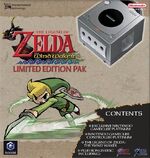
The limited edition pak
Limited Editions
A limited edition version of the game was released only in Europe. The game was bundled with Master Quest in a single case, different from North America where Master Quest was only available as a pre-order bonus and came in a separate case.
A limited edition pak was also released only in Europe. The bundle included a copy of the limited edition version of the game with Master Quest, a GameCube console available in both platinum and purple, and a controller matching the console's color.
Completion Records
| Time | Performer | Date | Notes |
|---|
| Category | Runner | Time | Date |
|---|---|---|---|
| Any% | Aloakirby | 52m 19s | September 27, 2022 |
| Any% (No Manual Super Swim) | gobbitybobbity | 1h 15m 25s | April 30, 2022 |
| Any% (No Actor Unloading or Barrier Skip) | Demon | 3h 48m 17s | July 5, 2018 |
| Any% (Limited Bugs) | nezumiirta | 5h 19m | June 19, 2017 |
| Any% (Moon Jump Cheat Allowed) | Kryptek | 37m 5s | November 6, 2017 |
| 100% | nukie | 14h 1m 51s | April 18, 2022 |
| 100% (Less Collectables) | minimini352 | 6h 13m 26s | July 13, 2022 |
| All Dungeons | gymnast86 | 2h 20m 54s | March 27, 2022 |
| Low% | EJ125 | 1h 29m 34s | April 29, 2022 |
| Low% (No Actor Unloading or Barrier Skip) | Demon | 4h 19m 45s | July 11, 2018 |
| Din's Pearl | iwabi74 | 27m 17s | October 17, 2020 |
| Obtain the Master Sword | gymnast86 | 1h 16m 39s | March 27, 2022 |
| Obtain the Master Sword Early | iwabi74 | 16m 44s | September 6, 2020 |
| 14 Small Keys | minimini352 | 4h 3m 44s | March 22, 2022 |
Listings
Characters
Bosses
Enemies
Dungeons
Places
Items and Objects
Charts
Credits
Glitches
Hacks
Reception
Sales
The Wind Waker was commercially successful, selling around 3.07 million copies worldwide,[29][30] becoming one of the most popular GameCube games of all time. However, most of the success comes from Europe and North America, as in Japan the game fared much worse than expected;[31] in fact, Eiji Aonuma commented that the low popularity of the game in the region would have meant the end of the franchise.
Reviews
Reviews of the game were mostly positive, especially in reference to the graphics style.[32] IGN editor Matt Cassamassina praised the graphics and gameplay, stating that the game takes the best of Ocarina of Time and improves it;[33] however, he criticizes the sound for the insistent use of MIDI tracks and nearly null voice speech.
GameSpot editor Jeff Gerstmann called the game "The Wind Waker is a strong achievement in every way, from its stunning graphical presentation to its tight control and interesting story line,"[34] but also criticized the relatively long periods of sailing (particularly in regards of the search for the Triforce Shard collection) and the relatively easy puzzles and boss battles.
From Eurogamer, another review site, Tom Bramwell also praised the game, giving his personal recommendation to it, although he also argued that Epona used to be a better means of transportation than the boat.[35] Nintendo Power ranked it sixth in their list of best The Legend of Zelda games, criticizing its sailing concept but praising the graphics and the refined gameplay "while on land."[36]
In March 2011, The Wind Waker was ranked 5th on GamesRadar's list of "The 100 Best Games Of All Time", placing it above Twilight Princess (29th), and A Link To The Past (17th).[37]
Fan Reception
Consumers' reception on the game was positive, with an average reader score of 9.1 on IGN[38] and a medium user score of 9.2 on GameSpot.[39] While fans initially expected a more realistic game with graphics more in line with the scene shown in the SpaceWorld 2000 GameCube Tech Demo, this was not the case for the final game. In 2001, the impressions on the game using cel-shading graphics were nothing short of mixed, rendering the game as controversial as Template:AoL and Majora's Mask initially were in past decades.[40] Upon its announcement, many in the fan community decried the art style of the game as childish and unfit for a Zelda title.[41] Video Gamer X, webmaster of The Odyssey of Hyrule, compared early screenshots for the game to the much-maligned CD-i titles, and accused Nintendo of making games with limited appeal to young children. He described the graphics as "animated C-quality Disney garbage."[42]
However, the game ultimately satisfied the consumer, leading to commercial and critical success. Yet, some players expressed complaints in regards of the sailing concept;[43] opinions were also mixed in regards of Tingle's role in this game, to the point that IGN editors requested his exclusion from the then-upcoming game Twilight Princess.[44]
Nonetheless, in 2006, The Wind Waker was placed in the 26th position on IGN's reader list of greatest games of all time.[45] Modern reception to the game is highly positive, with many citing the graphics as a strong point, and others resisting the changes to the style as seen in the game's HD remake.
Ports and Remakes
HD Remake
A Wii U remake of The Wind Waker was announced by Nintendo during a Nintendo Direct on January 23, 2013. [46] The game's new features include updated HD graphics, faster sailing, and an improved Picto Box. In addition, the Tingle Tuner has been replaced with the Tingle Bottle.[47]
Legacy
- After The Wind Waker's release, the Zelda games for the Nintendo DS utilzed the same graphical style.
- The engine of the game was the basis for those of Navi Trackers and Twilight Princess. Twilight Princess contains some leftover data from The Wind Waker, namely models for the Wind Waker and Bomb Flowers.[48]
- By extension, it's also the first game to evidence that the character Link, like Princess Zelda, has multiple incarnations over the decades/centuries.
- The sailing mechanic inspired the creation of the means of Transportation seen in the Nintendo DS Zelda games, and is similar to Link's method of transportation in Skyward Sword.
- Many properties of this game were borrowed by Super Smash Bros. Brawl, including Link's animated incarnation, a stage, parts of the soundtrack, and several trophies and stickers.
Trivia
- According to the original Japanese text, the Master Sword was sealing Ganon's minions ("mazoku", translates to "Demon Tribe" or "Demon Race"), as it can be observed in the game, and not his magic.
- According to the English translation of the game, Daphnes Nohansen Hyrule says that the Hero of Time, after defeating Ganon, embarked on another journey and left the land of Hyrule, which could be interpreted as a reference to Link's adventure in Termina. The Japanese text however, mentions that the hero left Hyrule traveling through time, apparently referencing Link's return to his original time at the end of the game.[11][49]
- According to the ‘Guinness World Records Gamers Edition 2008’, The Wind Waker had around 500,000 pre-orders and was at the time (2002) the most pre-ordered game on record.
- The game's main theme song includes both the Earth God's Lyric and the Wind God's Aria.
- The Wind Waker is the first Zelda game where every single boss has its own musical theme. In the subsequent games, however, at least two bosses share a common track.
- Link yells "Come on!" when he calls Medli, Makar, or a statue. This marked The Wind Waker as the only canon Zelda game to date in which Link has spoken in actual words until the release of Twilight Princess, in which Link can be heard yelling "Giddy-up!" as he rides Epona. In The Adventure of Link, a textbox does say "I found a mirror under the table" at one point, but the Japanese version used no pronouns and is written in much the same way as the "You got" speeches (that is, it's from Link's perspective, but not him speaking). Other characters also speak actual English words, most notably Beedle, who says "Welcome!", "Thank you!" and "Bye!".
- On the disc of the American version, the Hylian reads "Zeruda no Densetsu Kaze no Takuto," which is the game's name in Japan.
- The greeting "Hoy!" in this game is similar to the Portuguese "Oi!" or the Dutch "Hoi!" Additionally, "Oi!" is the equivalent of "Hey!" in Japanese. "Hoy" is also a saying used by sailors, of which the game holds many elements.
- The game contains a few references to previous games in the series, notably Ocarina of Time; the Hero of Time mentioned throughout the game and the various stained glasses in the Master Sword chamber are all from Ocarina of Time.
- The portal sound is created from the same audio sample used in the "Final Hours" theme from Majora's Mask.
- The entire ending cinematic, from when Link and Tetra are picked up by the pirate ship to the very end of the epilogue cutscene, is a pre-rendered FMV, as opposed to other cutscenes which are rendered in real-time, marking the first time prerendered FMVs have been used in a Zelda game. This cutscene was probably prerendered in order to properly implement the transition between the cutscene and the credits. Remnant text from a non-FMV ending exists in the game data.
- If the player has a file of both The Wind Waker and the GCN version of Metal Gear Solid, in the latter game the boss character Psycho Mantis makes a cameo mention of the former game during the battle.
- The game contains an abnormally large amount of unused/early content left in the data, likely a result of development being rushed during its later stages.
- The Wind Waker is notable for its test rooms, which are accessible with an Action Replay device. Interestingly, the textures in the test rooms and even one of the rooms themselves are shared with Super Mario Sunshine and Super Mario 64 DS. These textures consist of squares which have a certain number of meters per side; the number of meters is drawn on the textures. The Wind Waker's first test room contains transparent water in a pool, which is likely a leftover from the earliest stages of development when transparent water was going to be used in the ocean. Even more interesting is that a "walkable" slope is present under this water, suggesting an item, most likely the Iron Boots, would have allowed Link to walk underwater like in Ocarina of Time.[50] Another test room features textures that don't belong in the game itself, but was likely leftover from the early Spaceworld 2000 trailer of a techdemo featuring Link and Ganondorf, both resembling their Ocarina of Time counterparts, fighting in a dungeon that had similar textures.
- Staircases in the later parts of the game use ramp collision boxes instead of the stair programming seen in the rest of the game. Most of these ramp-stairs occur in the Hyrule Castle area, but some occur in the Forsaken Fortress. The main difference is that Link can roll up the ramp-stairs to move quickly, but will crash and fall back instead if he attempts to roll up regular stairs.
- A vast amount of unused stages, meant for the final release of the game, can be found within the disk.[51] Most notably, a huge amount of unused rooms are present in various degrees of completion.[52] These range from a very old forest area that was showcased in the game's first E3 trailer, to multiple test rooms, and even places intended for the final release, like a different design for the Tower of the Gods and an art studio on Tingle Island. More unused areas exist than the amount of islands in the final game.[citation needed]
- Hyrule Historia contains a compendium of this game's early concept art. It reveals many unused ideas for the game, some of which were implemented in later games. The most well known concept was of Link getting progressively older as the game went on, but was scrapped because of difficulties implementing this idea. Another example, an island resembling a Nintendo GameCube was drawn, possibly the source of inspiration for Dee Ess Island in Phantom Hourglass. Another concept was that Link could interact with the submerged Hyrule through special portals around the Great Sea, guarded by actual fishermen. This would likely have been the implementation of walking under water, as described above. Remnants of that idea can be seen via hacking Link to be under the ocean; he can walk on invisible ground below the water.
- The version of the Dragon Roost Island theme found on the game's soundtrack includes a plucked bass, which is not present in the original version of the theme found in the game. The version with the plucked bass was also used in Super Smash Bros. Brawl.
- Although the Korean version of The Wind Waker is actually the American version with Korea-specific region coding, its boxart is almost identical to that of the Japanese version, with the Japanese logo swapped out for the English (international) one.
- This is the fourth The Legend of Zelda title to be remade as well as the third console Zelda title to have a remake.
Gallery
Prologue
- Opening 1.png
- Normal opening 2.png
- Normal opening 3.png
- Normal opening 4.png
- Normal opening 5.png
- TWW-Legend19.png
Illustrations
Link being attacked by Miniblins in the Forsaken Fortress
- The Wind Waker Scene.jpg
Artwork depicting various key characters from the game
- GreatSeaIllustrationWW.png
A Stylized Illustration map of the Great Sea
Stained glass artwork featuring the Bow
- Zelda and Link-Stained Glass.jpg
Stained glass artwork featuring Link and Princess Zelda
Sages' Stained Glass Windows
- RauruTWW.png
- SariaTWW.png
- DaruniaTWW.png
- RutoTWW.png
- ImpaTWW.png
- NabooruTWW.png
Box Art
Limited Editions
Advertisements
| American Ad |
| Japanese Ad |
Related Articles
The Legend of Zelda: The Wind Waker Original Sound Tracks
External Links
- Official North American website
- Official Japanese website
- Nintendo Online Magazine Jan. 2003
- Unofficial Korean fansite entry for The Wind Waker
References
- ↑ The Legend of Zelda: The Wind Waker Review - Gaming Target
- ↑ [http://www.gamepro.com/article/news/27362/interview-with-nintendos-shigeru-miyamoto-and-eiji-aonuma/ Interview With Nintendo's Shigeru Miyamoto and Eiji Aonuma - GamePro]
- ↑ Game Examiner: Top 10 Best-Selling GameCube Games
- ↑ "Young girls with long ears like yours have been getting kidnapped, never to be seen again. And unless my eyes fail me, the young girl who was just kidnapped from this island also has long ears, does she not? Much like YOU do, Miss Fearsome Pirate. My point is that the bird mistook that poor girl for you, and that's why it grabbed her!" — Quill (The Wind Waker)
- ↑ "I am the King of Red Lions. Do not fear... I am not your enemy. Link...I have been watching you since you went to the Forsaken Fortress to rescue your sister. I understand how your desire to protect your sister could give you the courage to fearlessly stand up to anything...But such a bold attempt was foolhardy! I suppose you saw him... The shadow that commands that monstrous bird...His name is...Ganon...He who obtained the power of the gods, attempted to cover the land in darkness, and was ultimately sealed away by the very power he hoped to command. He is the very same Ganon...The emperor of the dark realm the ancient legends speak of...I do not know why the seal of the gods has failed, but now that Ganon has returned, the world is once again being threatened by his evil magic." — King of Red Lions (The Wind Waker)
- ↑ "The key to defeating Ganon is locked away in a great power that you can wield only after much toil and hardship." — King of Red Lions (The Wind Waker)
- ↑ "You cannot defeat me with a blade that does not sparkle with the power to repel evil! What you hold is useless." — Ganon (The Wind Waker)
- ↑ Template:Cite book
- ↑ "Foolish child. While that sword is indeed the blade of evil's bane, at the same time, it has long played another role...You see, it is also a sort of key...a most wretched little key that has kept the seal on me and my magic intact!" — Ganon (The Wind Waker)
- ↑ "My Triforce of Power is resonating! Ha! At long last, I have found you...Princess Zelda!" — Ganon (The Wind Waker)
- ↑ 11.0 11.1 "Once, long ago, he defeated Ganon and brought peace to the Kingdom of Hyrule... A piece of the Triforce was given to the Hero of Time and he kept it safe, much as Zelda kept hers. That sacred piece is known as the Triforce of Courage. When the Hero of Time was called to embark on another journey and left the land of Hyrule, he was separated from the elements that made him a hero. It is said that at that time, the Triforce of Courage was split into eight shards and hidden throughout the land." — King of Red Lions (The Wind Waker)
- ↑ "Long ago, Ganon's Tower was an impenetrable fortress that not even the daring and dauntless Knights of Hyrule could hope to assail." — King of Red Lions (The Wind Waker)
- ↑ "Gods! Hear that which I desire! Expose this land to the rays of the sun once more! Let them burn forth! Give Hyrule to me!!!" — Ganondorf (The Wind Waker)
- ↑ "Gods of the Triforce! Hear that which I desire! Hope! I desire hope for these children! Give them a future! Wash away this ancient land of Hyrule! Let a ray of hope shine on the future of the world!!! And let our destinies finally be fulfilled...Ganondorf! May you drown with Hyrule!!!" — Daphnes Nohansen Hyrule (The Wind Waker)
- ↑ "Ah, but child... That land will not be Hyrule. It will be YOUR land!" — Daphnes Nohansen Hyrule (The Wind Waker)
- ↑ GameCube Reviews: The Legend of Zelda: The Wind Waker - Game Revolution
- ↑ "Did I startle you? I suppose that is only natural. As wide as the world is, I am the only boat upon it who can speak the words of men." — King of Red Lions (The Wind Waker)
- ↑ "That tune you just picked up? Well, it gives you control over the direction the wind blows." — Zephos (The Wind Waker)
- ↑ "He gave you the Tingle Tuner! If you get stuck or need a quick hint, connect a Game Boy Advance to your Nintendo GameCube to talk to Tingle." — N/A (The Wind Waker)
- ↑ Previews - The Legend of Zelda: The Wind Waker
- ↑ The case of cute: Why The Wind Waker is the best Zelda ever
- ↑ The case of cute: Why The Wind Waker is the best Zelda ever
- ↑ Eiji Aonuma Interview
- ↑ Template:Cite web
- ↑ Template:Cite person
- ↑ Template:Cite person
- ↑ "So, before the sealing of the kingdom, the gods chose those who would build a new country and commanded them to take refuge on the mountaintops. Those people were your ancestors. Hundreds of years have passed since then... So long as Ganondorf was not revived, Hyrule would remain below, never waking from its slumber." — King of Red Lions (The Wind Waker)
- ↑ "Yes, surely you are the Hero of Time, reborn..." — Ganon (The Wind Waker)
- ↑ Game Examiner: Top 10 Best-Selling GameCube Games
- ↑ Template:Cite web
- ↑ GDC 07: Aonuma reflects on Zelda
- ↑ The Legend of Zelda: The Wind Waker - Game Rankings
- ↑ The Legend of Zelda: The Wind Waker Review
- ↑ The Legend of Zelda: The Wind Waker Review for GameCube
- ↑ The Legend of Zelda: The Wind Waker Review
- ↑ Nintendo power Issue #248 (December 2009), p. 72.
- ↑ GamesRadar - The 100 Best Games Of All Time
- ↑ The Legend of Zelda: The Wind Waker Reader Reviews on IGN
- ↑ The Legend of Zelda: The Wind Waker User Reviews on GameSpot
- ↑ The Legend of Zelda: The Wind Waker (Second Opinion) - GameCritics
- ↑ Template:Cite web
- ↑ Template:Cite web
- ↑ The Legend of Zelda: Twilight Princess Review - Lawrence.com
- ↑ IGNcube's 2004 "Die, Tingle, Die! Die!" campaign
- ↑ IGN Readers' Choice 2006 - The Top 100 Games Ever
- ↑ Template:Cite web
- ↑ Template:Cite web
- ↑ The Legend of Zelda: Twilight Princess - The Cutting Room Floor
- ↑ Template:Cite web
- ↑ The Legend of Zelda: The Wind Waker/Unused Rooms: Amos_T - The Cutting Room Floor
- ↑ The Legend of Zelda: The Wind Waker - The Cutting Room Floor
- ↑ The Legend of Zelda: The Wind Waker/Unused Rooms - The Cutting Room Floor


